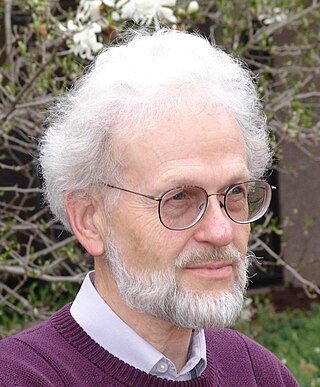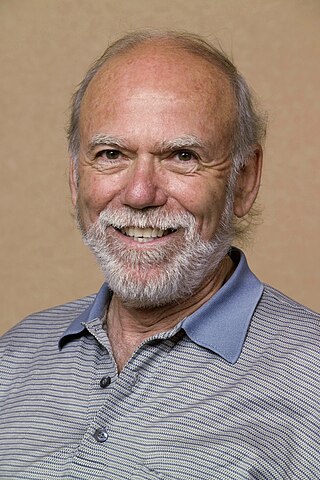Related Research Articles

James Watson Cronin was an American particle physicist.
The High Resolution Fly's Eye or HiRes detector was an ultra-high-energy cosmic ray observatory that operated in the West Desert of Utah from May 1997 until April 2006. HiRes used the "atmospheric fluorescence" technique that was pioneered by the Utah group first in tests at the Volcano Ranch experiment and then with the original Fly's Eye experiment. The experiment first ran as the HiRes prototype in a tower configuration operating in conjunction with the CASA and MIA. The prototype was later reconfigured to view 360 degrees in azimuth. HiRes-II followed later and was located on a hilltop about 13km away. HiRes-I and HiRes-II operated in stereo.
The Panofsky Prize in Experimental Particle Physics is an annual prize of the American Physical Society. It is given to recognize and encourage outstanding achievements in experimental particle physics, and is open to scientists of any nation. It was established in 1985 by friends of Wolfgang K. H. Panofsky and by the Division of Particles and Fields of the American Physical Society. Panofsky was a physics professor at Stanford University and the first director of the Stanford Linear Accelerator Center (SLAC). Several of the prize winners have subsequently won the Nobel Prize in Physics. As of 2021, the prize included a $10,000 award.

David Robert Nygren is a particle physicist known for his invention of the time projection chamber. He is a Presidential Distinguished Professor of Physics, University of Texas at Arlington now. He has worked at Lawrence Berkeley National Laboratory since 1973. He has been called "the most distinguished developer of particle detection instruments in the country".
Bruce Winstein was an experimental physicist and cosmologist noted for his early work in elementary particle physics, particularly work toward demonstrating a serious asymmetry between particles and their anti-particles. Later in his career, he worked in experimental cosmology, measuring polarization in the microwave background radiation whose properties date back to the early universe.

Barry Clark Barish is an American experimental physicist and Nobel Laureate. He is a Linde Professor of Physics, emeritus at California Institute of Technology and a leading expert on gravitational waves.
Timothy Maurice Paul Tait is a Canadian-American particle physicist known for his contributions to the theoretical physics and particle physics, particularly in the field of dark matter. He is currently a professor in the Department of Physics and Astronomy at the University of California, Irvine.
Gail G. Hanson, born 22 February 1947 in Dayton, Ohio is an American experimental particle physicist.
Ramanath Cowsik is an Indian astrophysicist and the James S. McDonnell Professor of Space Sciences at Washington University in St. Louis. He is considered by many as the father of astroparticle physics. A recipient of the Shanti Swarup Bhatnagar Prize, Cowsik was honored by the Government of India, in 2002, with the fourth highest Indian civilian award of Padma Shri

Takaaki Kajita is a Japanese physicist, known for neutrino experiments at the Kamioka Observatory – Kamiokande and its successor, Super-Kamiokande. In 2015, he was awarded the Nobel Prize in Physics jointly with Canadian physicist Arthur B. McDonald. On 1 October 2020, he became the president of the Science Council of Japan.

The College of Science at the University of Utah is an academic college of the University of Utah in Salt Lake City, Utah. The college offers undergraduate and graduate degrees in atmospheric science, biology, chemistry, geology and geophysics, mathematics, metallurgical engineering, mining engineering and physics and astronomy.
Eugene Chen Loh was a Chinese American physicist, having been Distinguished Professor Emeritus at University of Utah and was a Fellow of the American Physical Society.
David George Hitlin is a professor at the California Institute of Technology, specializing in experimental particle physics.
Clement Laurence Pryke is an English-American physicist, focusing in astrophysics and cosmology, particularly on the cosmic microwave background.

Angela Villela Olinto is provost of Columbia University and an astroparticle physicist. Previously, she served as the Albert A. Michelson Distinguished Service Professor at the University of Chicago as well as the dean of the Physical Sciences Division. Her current work is focused on understanding the origin of high-energy cosmic rays, gamma rays, and neutrinos.
Bernard Sadoulet is a French physicist.

Mildred Widgoff was an American experimental particle physicist and astroparticle physicist who became the first female faculty member at the Brown University physics department.
Joshua A. Frieman is a theoretical astrophysicist who lives and works in the United States. He is a senior scientist at Fermilab and a professor of astronomy and astrophysics at the University of Chicago. Frieman is known for his work studying dark energy and cosmology, and he co-founded the Dark Energy Survey experiment. He was elected a member of the National Academy of Sciences in 2022.
Adam Leibovich is an American theoretical physicist. He is a full professor and the Betty J. and Ralph E. Bailey Dean of the Kenneth P. Dietrich School of Arts and Sciences and the College of General Studies at the University of Pittsburgh. His research is primarily in quantum chromodynamics (QCD) and the application of effective field theory to problems of hadronic physics, particularly particles containing one or more heavy quarks. Leibovich also has worked on gravitational wave physics. He was elected a fellow of the American Physical Society in 2017 and a fellow of the American Association for the Advancement of Science in 2018.

Sheldon Leslie Stone was a distinguished professor of physics at Syracuse University. He is best known for his work in experimental elementary particle physics, the Large Hadron Collider beauty experiment (LHCb), and B decays. He made significant contributions in the areas of data analysis, LHCb detector design and construction, and phenomenology.
References
- ↑ "Pierre Sokolsky". utah.edu. Retrieved February 11, 2017.
- ↑ "Distinguished Professors List" (PDF). utah.edu. Archived from the original (PDF) on January 12, 2017. Retrieved February 11, 2017.
- ↑ "Sokolsky, Pierre". worldcat.org. Retrieved February 11, 2017.
- ↑ "CURRICULUM VITAE Pierre Sokolsky" (pdf). January 2017. Retrieved 2018-11-09.
- ↑ "2008 W.K.H. Panofsky Prize in Experimental Particle Physics Recipient". American Physical Society. Retrieved 19 March 2017.